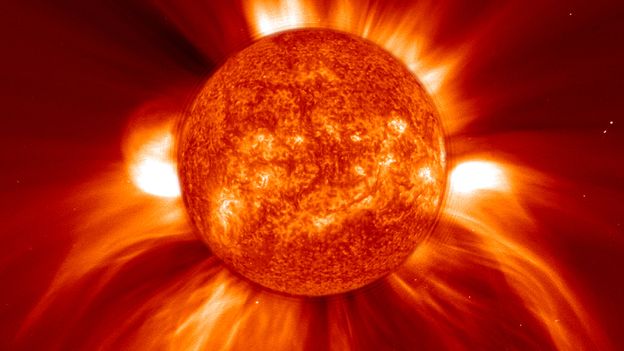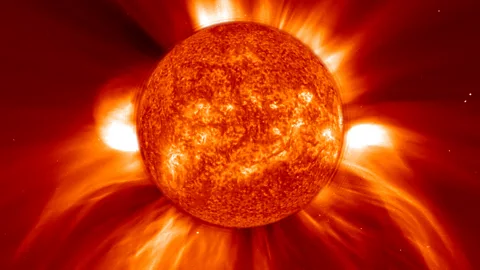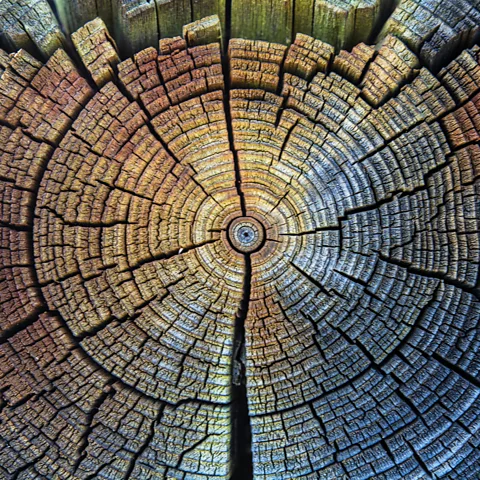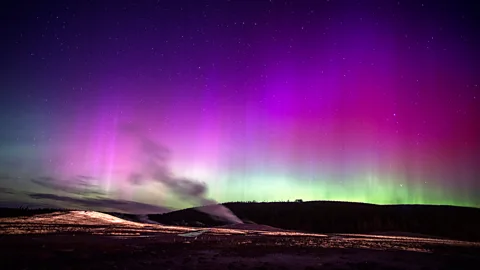
 Nasa
NasaThe Sun is going through a period of high activity, but it is nothing compared to an enormous solar event that slammed into our planet 14,000 years ago. If one were to occur today, the effect on Earth could be devastating.
The oldest trees on Earth date back a whopping 5,000 years, living through all manner of events. They have stood through the rise and fall of the Roman Empire, the birth of Christianity, the European discovery of the Americas and the first Moon landing. Trees can even be fossilised in soil underground, giving us a connection to the last 30,000 years.
At first glance, these long-lived specimens might just appear to be static observers, but not so. They are doing something extraordinary as they grow – recording the activity of our Sun.
As trees photosynthesise throughout the year, they change in colouration depending on the season, appearing lighter in spring and darker by autumn. The result is a year-on-year record contained within the growth “rings” of the tree. “This gives us this really valuable archive of time capsules,” says Charlotte Pearson, a dendrochronologist – someone who studies tree rings – at the Laboratory of Tree-Ring Research at the University of Arizona, US.
For most of the 20th Century, dendrochronologists have largely used tree rings to investigate change across wide chunks of history – a decade or more. Yet at certain points in time, the change they document has been more sudden and cataclysmic. What they are finding evidence of are massive solar events that reveal disturbing insights into the turbulent recent past of the star at the centre of our Solar System.
“Nobody was expecting a brief event to appear,” says Edouard Bard, a climatologist at the College de France in Paris. But in 2012 a then-PhD student called Fusa Miyake, now a cosmic ray physicist at Nagoya University in Japan, made an astonishing discovery. Studying Japanese cedar trees, she discovered a huge spike in a type of carbon known as carbon-14 in a single year nearly 800 years ago, in 774 CE. “I was so excited,” says Miyake.
After doubting the data at first, Miyake and her colleagues soon came to an unnerving conclusion. The spike in carbon-14 must have come from something injecting huge numbers of particles into our atmosphere, since this radioactive isotope of carbon is produced when high-energy particles strike nitrogen in the atmosphere. Once linked perhaps to cosmic events like supernovae, studies have since suggested another probable cause: a monster burst of particles thrown out by the Sun. These would be generated by superflares, far bigger than anything seen in the modern era.
“They require an event that’s at least ten times bigger than anything we’ve observed,” says Mathew Owens, a space physicist at the University of Reading in the UK. The first recorded solar flare sighting dates back to the middle of the 19th Century, and are associated with the great geomagnetic storm of 1859, which has become known as the Carrington Event, after one of the astronomers who observed it, Richard Carrington.
 Getty Images
Getty ImagesMiyake’s discovery was confirmed by other studies of tree rings and analysis of ancient ice in cores collected from places such as Antarctica and Greenland. The latter contained correlated signatures of berylium-10 and chlorine-36, which are produced in a similar atmospheric process to carbon-14. Since then, more Miyake events, as these massive bursts of cosmic radiation and particles are now known, have been unearthed. In total, seven well studied events are known to have occurred over the past 15,000 years, while there are several other spikes in carbon-14 that have yet to be confirmed as Miyake events.
The most powerful known Miyake event was discovered as recently as 2023 when Bard and his colleagues announced the discovery of a carbon-14 spike in fossilised Scots pine trees in Southern France dating back 14,300 years. The spike they saw was twice as powerful as any Miyake event seen before, suggesting these already-suspected monster events could be even bigger than previously thought.
What causes the Northern Lights?
Aurorae are caused when charged particles from the Sun are funnelled by Earth’s magnetic field to the poles. Here, they collide with gases in our atmosphere, producing different colours as the clashes take place. The more powerful the solar event, the larger the aurorae can be. Earth’s magnetic field can also be affected by the increased solar activity, causing a geomagnetic storm.
The team behind the discovery of this superstorm from space had scoured the Southern French Alps for fossilised trees and found some that had been exposed by rivers. Using a chainsaw, they collected samples and examined them back in a laboratory, discovering evidence for an enormous carbon-14 spike. “We dreamed of finding a new Miyake event, and we were very, very happy to find this,” says Cécile Miramont, a dendrochronologist at Aix-Marseille University in France and a co-author on the study.
If such an event were to occur again today, however, the impacts would be unprecedented. “People who lived thousands of years ago would have probably seen aurora, they would have seen lights in the sky,” says Pearson. “They might have marvelled at that. But beyond that, this wouldn’t have impacted them at all. We’re the first society on Earth that might witness one of these events who would be intensely vulnerable and massively impacted by it.”
These storms can cause mayhem on Earth. Geomagnetic storms can swell our atmosphere, increasing atmospheric drag on satellites (the Hubble telescope dropped by 40-80m (141-262ft) a day during the geomagnetic storms in May 2024, for example). They can also play havoc with power networks, overpowering those that are not switched off in time, a fate that befell Quebec in 1989 when one of its power grids was knocked out for nine hours and left six million people – a quarter of Canada’s population – without power.
The most powerful solar storm in recent history, the Carrington Event of 1859, triggered intense auroral light shows in both hemispheres of our planet and triggered electrical surges that knocked out in telegraph lines around the world. Today, the effects of a Carrington-level event would be disasterious. In worst case scenarios, the Global Positioning System (GPS) could break down as satellites are pushed out of place or their delicate electronics damaged, while multiple power grids on Earth and even the internet could fail. In 2013, a report estimated the economic loss in the US alone from a Carrington-level event could be $0.6tn-$2.6tn (£0.4tn-£2tn).
Miyake events, however, are a different beast – causing blasts of particles at least ten times larger than the Carrington event. In fact, so small was the Carrington event by comparison that any spike of carbon-14 it produced barely shows up in tree rings at all. In March, a study found a very subtle hint of carbon-14 from the Carrington event, but nothing compared to a Miyake event. “It doesn’t show up”, says Pearson. “Either that means there’s something different [going on], or [Miyake events are] on a much greater scale than the Carrington event. That’s where the potentially dramatic side lies. If they are events like the Carrington event but just on a larger scale, we need some serious mitigation strategies as quickly as possible.”
An event on the scale of the one that swept over the Earth 14,300 years ago could cause such widespread damage to the modern technology our lives rely upon it is hard to fathom.
“The Carrington event is presumed to be the worst-case scenario,” says Raimund Muscheler, a solar scientist at Lund University in Sweden. “So the question is, could they really be much worse?”
 Getty Images
Getty ImagesWe know that some stars, particularly red dwarves which are smaller and dimmer than our Sun, are prone to superflares that can rip apart the atmospheres of planets orbiting nearby. While it’s unlikely our Sun poses such a danger to Earth, the existence of Miyake events does raise the possibility that it is capable of bursts of much more extreme activity than the 11-year-cycle we observe today – and much more powerful than even the Carrington event.
What’s unclear at the moment is the link between Miyake events and geomagnetic storms. The carbon-14 spikes produced in the events likely come from bursts of highly energetic particles from the Sun. But it’s not certain if these events are always linked to CMEs that cause powerful geomagnetic storms on Earth. “When you have very big storms at the Sun, you often get a lot of energetic particles and CMEs,” says Silvia Dalla, a solar physicist at the University of Central Lancashire. But she notes the link is “not exactly one to one”.
Energetic particles can also stream from sunspots, twisted magnetic fields that cool portions of the Sun’s surface and drive activity, but not all also produce large eruptions. Some researchers say there does not appear to be a correlation between Miyake events and sunspots. Intead they say the could be due to far more prolonged storms and bursts of solar activity that go on for a year or more.
For our technology dependent world, that is deeply troubling.
Confronted with such a barrage of high energy particle and radiation, all but the best shielded equipment could be vulnerable.
“Satellites could be destroyed,” says Muscheler.
Infrastructure on Earth would be at risk too. “You get particles that whizz through a chip and change one of the bits from a one to a zero,” says Owen. It is something that occurs from time to time under normal conditions, leading to baffling and unexpected computer errors. But a Miyake event would cause so many that electronic systems would likely become unusable or even destroy the delicate circuitry. (Read more about the computer errors from outer space.)
“In something that’s controlling the fuel going in and out of a nuclear power station, you really worry about that stuff,” says Owens. “In space weather we tend to talk about the one-in-100-year events, but the nuclear industry is often worried about the one-in-1,000-year events, the really big stuff.”
Bursts of solar particles would play havoc with aviation too, causing flights to be diverted away from the poles where the incoming particles would be funnelled by the Earth’s magnetic field, to prevent passengers being exposed to potentially harmful levels of radiation. But given these particles travel from the Sun to Earth at close to the speed of light, a journey of just eight minutes, there would be little time to prepare. “You tend to know an event is ongoing more than you can really forecast them,” says Owens.
 Getty Images
Getty ImagesOf course, tree rings only give us a snapshot of an entire year in which a Miyake event has occurred, so it’s still unclear if the events would be the result of one single catastrophic solar burst, or multiple periods of increased activity over a year. “We don’t know whether that was one single event on one day, the superflare hypothesis, or there just happened to be an unusually large number of very big particle storms in that year,” says Owens. Each of those storms, however, would still be large and potentially dangerous.
Futher analysis of tree rings and ice cores to look for more Miyake events is ongoing in the hope it will provide more answers. “I think more events are hidden,” says Miyake. An estimated 95% of tree ring data from the past 5,000 years has been studied, says Nicolas Brehm, a solar scientist at ETH Zurich, a public research university in Switzerland, meaning it’s unlikely there are many more Miyake events to be found in recent history. Beyond that, there is a limit of about 30,000 years worth of data in preserved wood, although that analysis is difficult. “It’s hard to get good material from this time period,” says Brehm.
Despite this, the hunt for more Miyake events goes on. In June, Bard returned to the French Alps to collect samples of more exposed fossilised trees. Now, with samples in tow, he will begin “the tedious work” of studying the tree rings, he says, over several months. Perhaps, one day, an even bigger event than that 14,300 years ago will be found.
And of course there is still the chance one could happen again. We had better hope we are ready for it.
For more science, technology and health stories from the BBC, follow us on Facebook and X.
